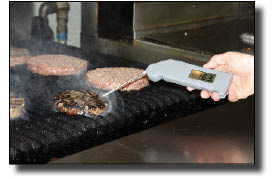6: Major Causes of Foodborne Illness
Audio Version
The major risk factors associated with foodborne illness can be broken down into several major categories: inadequate cooking, improper holding temperatures, contaminated equipment, poor personal hygiene and food obtained from unsafe sources.
Examples of inadequate cooking include cooking chicken breasts to 155° F (68° C) instead of the required temperature of 165° F (74° C) or higher, cooking ground beef to 135° F (57° C) instead of the required temperature of 155° F (68° C) or higher, or even cooking eggs “over-easy” which does not meet the required temperature of 145° F (63° C) or higher.

Examples of improper holding temperatures include holding sliced tomatoes at a salad bar at 50° F (10° C) instead of the required temperature of 41° F (5° C) or lower, holding a pan of meatballs at a buffet at 125° F (52° C) instead of the required temperature of 135° F (57° C) or higher, or displaying pizza at room temperature instead of placing it in a warming unit that is able to hold it at 135° F (57° C) or higher.
Examples of contaminated equipment include using a cutting board to slice raw chicken, then using that same cutting board to chop lettuce, storing a cooked product in a container that had previously stored raw meat, or dropping a spoon on the floor and continuing to use it without cleaning and sanitizing it properly.

Examples of contaminated equipment include using a cutting board to slice raw chicken, then using that same cutting board to chop lettuce, storing a cooked product in a container that previously stored raw meat, or dropping a spoon on the floor and continuing to use it without cleaning and sanitizing it properly.
Examples of poor personal hygiene include not bathing on a daily basis, not washing hands regularly, not washing hands thoroughly, not wearing gloves while handling ready-to-eat food (RTE food), leaving open cuts or sores on hands and wrists uncovered, or coming to work while sick.
Finally, an example of food obtained from an unsafe source would be purchasing pies from your friend’s mother who has decided to go into the pie business. She decides that she is going to make all the pies in her home and sell them to restaurants. Let’s say she also has a day care business in the home. You’ve got these pies being prepared and baked in a home where there are kids in diapers. Maybe they also use the kitchen counter as a table to change these diapers. The counter is not cleaned thoroughly – the same counter where the dough is going to be rolled. You get the point.
You should always be conscious of these major causes (risk factors) of foodborne illness whether you are at work or at home and during every step of food handling from the moment the food is purchased, to when it is received, stored, prepared, thawed, cooked, held and finally to when your customers are served.
